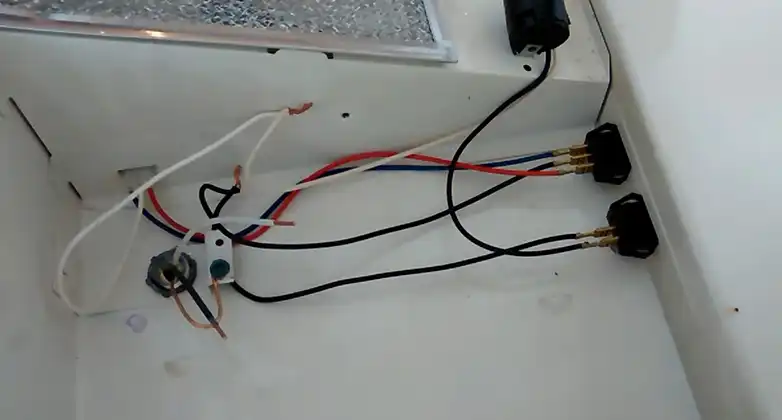Installing a range hood in your kitchen can help improve air quality by removing smoke, odors, and grease particles. While many range hoods are hardwired directly into your home’s electrical system, there are situations where you might want to wire it to a plug for more flexibility.
This article will guide you through the process of wiring a range hood to a plug, step by step. So, if you want to know how to wire a range hood to a plug, continue reading.

Wiring a Range Hood to a Plug
Wiring a range hood to a plug is a straightforward process that allows for flexibility and ease of installation. Whether you’re replacing an existing hardwired hood or setting up a new one, this guide will walk you through the necessary tools, materials, and step-by-step wiring instructions.
Necessary Tools and Materials
- Range Hood: Ensure you have a compatible range hood that can be connected to a plug. Most range hoods come with a wiring diagram that can help you identify the proper connections.
- Plug: Purchase a grounded electrical plug with the appropriate amperage rating for your range hood. Typically, a 15-amp plug is sufficient for residential range hoods.
- Cable: You’ll need a length of electrical cable (usually 14-2 or 12-2 gauge) with two insulated wires (black and white) and a ground wire (green or bare).
- Screwdrivers: Both flathead and Phillips screwdrivers will be useful for securing wires and attaching the plug.
- Wire Strippers: You’ll need these to strip the insulation off the wires.
- Wire Nuts: Use wire nuts to secure the connections between wires.
- Electrical Tape: It’s a good idea to wrap connections with electrical tape for added safety.
- Cable Clamps: These are used to secure the cable to the range hood and the plug box.
- Voltage Tester: To ensure the power is off before you start working.
- Drill and Screws: If your range hood doesn’t already have a knockout hole for the cable, you’ll need these to create one.
Step-by-Step Wiring Instructions
Follow these steps to wire your range hood to a plug:
Step 1: Safety First
Turn Off Power: Before you begin, turn off the power to the circuit where you’ll be working. Use a voltage tester to confirm that there is no electricity flowing into the area.
Step 2: Prepare the Range Hood
Locate the Knockout Hole: If your range hood doesn’t have a knockout hole for the cable, carefully drill a hole in a suitable location. Ensure it is large enough to fit the cable.
Remove the Cover: Open the cover or access panel on the range hood to expose the wiring compartment.
Step 3: Prepare the Cable
Strip the Wires: Strip about half an inch of insulation from the black and white wires and about three-quarters of an inch from the ground wire.
Step 4: Connect the Wires
Connect Black to Black, White to White, and Green to Green: Match the wires from the cable to the wires in the range hood. Typically, black is for hot, white is for neutral, and green (or bare) is for ground. Use wire nuts to secure the connections, and wrap them with electrical tape for added safety.
Step 5: Secure the Cable
Use Cable Clamps: Secure the cable to the range hood with cable clamps to prevent it from moving or getting damaged.
Step 6: Mount the Plug Box
Choose a Location: Decide where you want to install the plug box. It should be within reach of the range hood’s cable and close to an electrical outlet.
Install the Box: Mount the plug box securely to the wall or another suitable surface. Ensure it is level and properly anchored.
Step 7: Wire the Plug
Strip the Cable: Strip the outer sheath of the cable to expose the individual wires inside.
Connect the Wires: Connect the black wire from the cable to the brass (hot) terminal on the plug, the white wire to the silver (neutral) terminal, and the green/bare wire to the green (ground) terminal. Tighten the terminal screws securely.
Step 8: Test the Connection
Turn On Power: Restore power to the circuit and test the range hood by turning it on. Ensure it functions properly.
Precautions
Proper Grounding: Ensure that the ground wire is properly connected. This is critical for safety.
Follow Local Codes: Adhere to local electrical codes and regulations. If you are unsure, consult a licensed electrician.
People Also Search For
Can I use an extension cord instead of wiring a plug directly to the range hood?
It’s not recommended to use an extension cord for a permanent installation. Extension cords are not designed for long-term use and can pose safety hazards.
Do I need an electrician to do this?
While wiring a range hood to a plug is a relatively straightforward task, if you’re uncomfortable working with electricity or unsure of your abilities, it’s always a good idea to consult a licensed electrician.
Can I use a GFCI (Ground Fault Circuit Interrupter) outlet for the plug?
Yes, using a GFCI outlet can provide an extra layer of safety, especially in kitchens where water is present. It’s a recommended practice.
What if my range hood has more wires than just black, white, and green?
If your range hood has additional wires (e.g., for lighting or fan speed control), consult the manufacturer’s wiring diagram or seek professional assistance to ensure proper connections.
Final Thoughts
Wiring a range hood to a plug can provide convenience and flexibility in your kitchen. By following these steps, you can ensure a safe and functional installation. If you have any doubts or questions, don’t hesitate to seek professional help to ensure your range hood is wired correctly.

![Read more about the article [Answered] Can You Use Semi Rigid Duct For Range Hood?](https://kitchenhoodcare.com/wp-content/uploads/2023/09/can-you-use-semi-rigid-duct-for-range-hood-300x161.webp)
![Read more about the article [Answered] What Is a Convertible Vent Hood?](https://kitchenhoodcare.com/wp-content/uploads/2023/09/What-Is-a-Convertible-Vent-Hood-300x161.webp)
